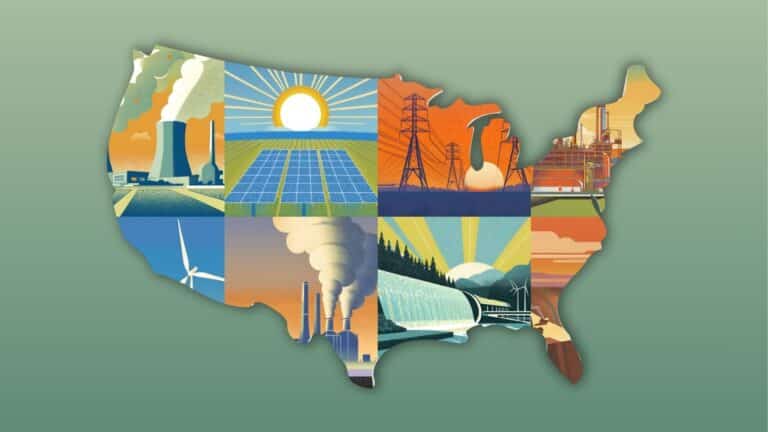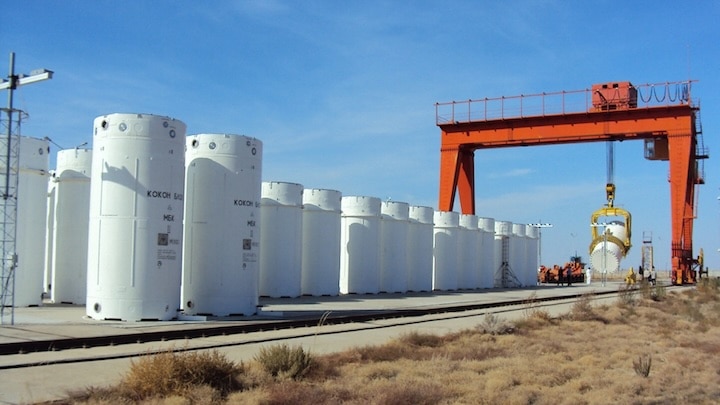Big banks predict catastrophic warming, with profit potential
Morgan Stanley, JPMorgan and an international banking group have quietly concluded that climate change will likely exceed the Paris Agreement's 2 degree
Current Access Level “I” – ID Only: CUID holders, alumni, and approved guests only
Q&A by Erica Downs • March 16, 2022
The United States and other countries have imposed sanctions on Russia in response to its invasion of Ukraine.[1] China, which opposes sanctions, has not acted accordingly. To the contrary, Chinese officials have stated that China will not participate in such sanctions and will maintain normal economic trade and financial exchanges with Russia.[2] Consequently, some observers wonder whether China will seek to sign new energy trade and investment deals on attractive terms that might also help ease the effects of Russia’s growing economic isolation.[3]
In this piece, Dr. Erica Downs, a senior research scholar with the Center on Global Energy Policy, discusses the state of the China-Russia relationship and how it might evolve in response to Russia’s invasion of Ukraine.
How much crude oil, natural gas, and coal does China import from Russia?
China imports large amounts of all three commodities. In 2021:
What is the significance of Chinese oil and natural gas investments in Russia? Have they simply provided capital for routine exploration and production or have they played a catalytic role?
China’s investments have catalyzed the development of LNG projects in Russia’s Far North. Specifically, Chinese entities played a key role in helping Novatek, Russia’s largest independent natural gas producer, deliver Yamal LNG on-time and on-budget in December 2017 despite Western sanctions. The development of Yamal LNG supports Moscow’s goal of diversifying Russia’s natural gas exports through LNG.[7]
Chinese entities participate in Yamal LNG as investors, lenders, offtakers, and contractors:
Chinese entities are playing similar albeit smaller roles in the development of Novatek’s Arctic LNG 2.
What oil and natural gas supply deals were signed during Putin’s visit to Beijing in February?
Chinese and Russian companies signed two agreements.
Gazprom signed a long-term agreement with CNPC for the supply of 10 bcm of natural gas per year through a new pipeline from Russia to China.[12] Natural gas will be sourced from the Russian Far East, probably Sakhalin-3. New gas sales reportedly will be settled in euros in an effort to diversify away from payments in US dollars.[13] Gazprom and CNPC did not mention the agreement’s duration or when deliveries will start. However, Reuters reported the agreement will run for 30 years with the first gas delivery in two to three years.[14]
Rosneft, Russia’s largest oil producer, agreed to deliver 200,000 bpd of crude oil to CNPC over 10 years through the Kazakhstan-China pipeline.[15] The pipeline’s capacity is 400,000 bpd, of which only 20,000 bpd is used by Kazakhstan.[16] The new contract extends a supply agreement that expires in 2023.[17]
Can Russia divert to China the natural gas it currently sells to Europe?
Today, Russia does not have the pipeline infrastructure to divert natural gas flows from west to east. However, Russia almost certainly could reallocate some of the LNG it ships to Europe to China.
Most of Russia’s export pipelines flow west. Gazprom, which has a monopoly on pipeline gas exports, has a map on its website showing 10 export pipelines: nine go to Europe—including the not-yet-operational Nord Stream 2—and one goes to China.[18] The capacity of the eight pipelines delivering gas to Europe (219.5 bcm) is nearly six times that of the pipeline to China, Power of Siberia (38 bcm), which is not operating at full capacity. In 2020, Gazprom exported 174.9 bcm to Europe and 4.1 bcm to China.[19]
That said, if China and Russia agree to build the Power of Siberia 2 pipeline, it would allow Gazprom to send an additional 50 bcm to China.[20]
LNG is a different story. In 2020, Russia exported 17.2 bcm of LNG to Europe, and China imported 94 bcm.[21] Of the 94 bcm China imported, almost 40 bcm were spot purchases.[22] These numbers suggest that China has the capacity to absorb more Russian LNG.
Will China buy the barrels of Russian oil that other companies are currently shunning?
Chinese purchases of additional barrels of Russian oil are likely to be shaped by several factors.
For state-owned refiners, these include how many barrels can be displaced from other suppliers, the availability of processing capacity and storage, and the extent to which Russian barrels are discounted.
For China’s independent refiners, which are highly opportunistic buyers, price probably will be paramount. However, some independent refiners are pausing purchases of Russian crude due to uncertainty over sanctions.[23] Other independents, unable to secure letters of credit from banks, are looking for alternative payment methods, which may impact short-term purchases.[24]
Discounted Russian barrels may also end up in China’s strategic petroleum reserve, but high crude prices may limit restocking.
How are Chinese banks responding to the risk of sanctions on Russia’s energy exports?
Anecdotal information indicates China’s banks are concerned about running afoul of any future US sanctions.
Will China’s national oil companies (NOCs) buy the oil and natural gas assets worth billions of dollars left behind by Western oil companies exiting Russia?
Assets that companies such as BP, Shell, and Exxon Mobil are walking away from might be attractive to China’s NOCs, especially if they can be purchased on the cheap. Additionally, there may be opportunities for China’s NOCs to buy shares of Russian companies at very low prices.[28] However, whether China’s NOCs acquire any of these assets is likely to be decided by Beijing and Moscow.
Notes
[1] “Fact Sheet: Joined by Allies and Partners, the United States Imposes Devastating Costs on Russia,” The White House, February 24, 2022, https://www.whitehouse.gov/briefing-room/statements-releases/2022/02/24/fact-sheet-joined-by-allies-and-partners-the-united-states-imposes-devastating-costs-on-russia/.
[2] See, for example, “China Won’t Take Part in Western Financial Sanctions on Russia: Bank Regulator Chief,” Wall Street Journal, March 2, 2022, https://www.wsj.com/livecoverage/russia-ukraine-latest-news-2022-03-02/card/china-won-t-take-part-in-western-financial-sanctions-on-russia-bank-regulator-chief-uWcY1AvqXs5ssr2057HAhttps://www.fmprc.gov.cn/mfa_eng/xwfw_665399/s2510_665401/2511_665403/202202/t20220228_10646378.html.
[3] See, for example, Weizhi Tan, “China is seen pursuing its ‘own interests’ as it decides whether to help Russia,” CNBC, March 14, 2022, https://www.cnbc.com/2022/03/14/columbia-university-on-china-helping-russia-with-impact-of-sanctions.html.
[4] Customs Database, http://43.248.49.97/. (For China’s imports and exports.)
[5] Ibid.
[6] Muyu Xu and Chen Aizhu, “China Russian coal purchases stall as buyers struggle to secure financing,” Reuters, March 1, 2022, https://www.reuters.com/business/chinas-russian-coal-purchases-stall-buyers-struggle-secure-financing-2022-03-01/.
[7] Tatiana Mitrova, “Russian LNG: The Long Road to Export,” IFRI Russia/NIS Center, December 2013, https://www.ifri.org/sites/default/files/atoms/files/defifrimitrovalngengdecember2013.pdf.
[8] “Yamal LNG: the gas that came in from the cold,” Total Energies, https://totalenergies.com/energy-expertise/projects/oil-gas/lng/yamal-lng-cold-environment-gas.
[9] “Yamal LNG Signed Loan Agreements with the Export-Import Bank of China and the China Development Bank,” Yamal LNG, April 29, 2016, https://www.novatek.ru/common/upload/doc/2016_04_29_press_release_Chinese_banks_FA_(ENG).pdf
[10] “Binding Contract on LNG Supply Concluded with CNPC,” Yamal LNG, May 20, 2014, http://yamallng.ru/en/press/news/283/.
[11] Vita Spivak and Alexander Gabuev, “The Ice Age: Russia and China’s Energy Cooperation in the Arctic,” Carnergie Moscow Center, December 31, 2021, https://carnegiemoscow.org/commentary/86100.
[12] “Gazprom and CNPC Sign Agreement for Gas Supply to China via Far Eastern Route,” Gazprom Export, February 4, 2022, https://web.archive.org/web/20220207175451/http://www.gazpromexport.ru/e….
[13] Anna Galtsova and Jenny Nguyen Yang, “Strengthening ties: A second pipeline import contract to send 10 bcm/y from Russia to China,” IHS Markit, February 21, 2022, https://ihsmarkit.com/research-analysis/strengthening-ties-a-second-pipeline-import-contract-to-send-1.html.
[14] Chen Aizhu, “Russia, China agree 30-year gas deal via new pipeline, to settle in euros,” Reuters, February 4, 2022, https://www.reuters.com/world/asia-pacific/exclusive-russia-china-agree-30-year-gas-deal-using-new-pipeline-source-2022-02-04/.
[15] Rosneft Oil Company regulatory announcement, “Rosneft and CNPC strengthen oil supply cooperation,” Bloomberg, February 4, 2022, https://www.bloomberg.com/press-releases/2022-02-04/rosneft-oil-company-rosneft-and-cnpc-strengthen-oil-supply-cooperation.
[16] “Rosneft to extend oil supply to China via Kazakhstan,” Argus, February 4, 2022, https://www.argusmedia.com/en/news/2298745-rosneft-to-extend-oil-supply-to-china-via-kazakhstan.
[17] Ibid.
[18] “Transportation,” Gazprom Export, https://web.archive.org/web/20220303052423/https://gazpromexport.ru/en/p….
[19] “Delivery Statistics – Gas supplies to Europe,” Gazprom Export, https://web.archive.org/web/20220303185914/http://www.gazpromexport.ru/en/statistics/https://tass.com/economy/1361535.
[20] “Putin, Xi Jinping discuss Power of Siberia 2 project, says Kremlin aide,” TASS, December 15, 2021, https://tass.com/economy/1375983.
[21] BP Statistical Review of World Energy 2021, BP, page 44, https://www.bp.com/content/dam/bp/business-sites/en/global/corporate/pdfs/energy-economics/statistical-review/bp-stats-review-2021-full-report.pdf.
[22] Wholesale Gas Price Survey: 2021 Edition, International Gas Union, June 2021, page 21, https://www.igu.org/resources/global-wholesale-gas-price-survey-2021/.
[23] “Factbox: A look at key Russia-China crude oil ties as Ukraine crisis rages,” S&P Global, March 8, 2022, https://www.spglobal.com/commodity-insights/en/market-insights/latest-news/oil/030122-factbox-a-look-at-key-russia-china-crude-oil-ties-as-ukraine-crisis-rages.
[24] Chen Aizhu and Florence Tan, “RPT – Chinese refiners tap alternative payments to keep Russian oil flowing – sources,” Reuters, March 6, 2022, https://www.reuters.com/article/ukraine-crisis-china-oil/rpt-chinese-refiners-tap-alternative-payments-to-keep-russian-oil-flowing-sources-idUSL2N2VA03D.
[25] “China’s State Banks Restrict Financing for Russian Commodities,” Bloomberg News, February 25, 2022, https://www.bloomberg.com/news/articles/2022-02-25/chinese-state-banks-restrict-financing-for-russian-commodities.
[26] “Update 1 – Bank of China’s Singapore operation stops financing Russian oil trades -source,” Reuters, February 27, 2022, Factiva.
[27] Muyu Xu and Chen Aizhu, “China’s Russian coal purchases stall as buyers struggle to secure financing,” Reuters, March 1, 2022, https://www.reuters.com/business/chinas-russian-coal-purchases-stall-buyers-struggle-secure-financing-2022-03-01/
[28] “China Considers Buying Stakes in Russian Energy, Commodity Firms,” Bloomberg News, March 8, 2022, https://www.bloomberg.com/news/articles/2022-03-08/china-considers-buying-stakes-in-russian-energy-commodity-firms.
President Donald Trump has made energy a clear focus for his second term in the White House. Having campaigned on an “America First” platform that highlighted domestic fossil-fuel growth, the reversal of climate policies and clean energy incentives advanced by the Biden administration, and substantial tariffs on key US trading partners, he declared an “energy emergency” on his first day in office.

November’s election for president of the United States will have crucial implications for the nation’s and world’s energy and climate policies.

Nuclear power is being weighed in energy transition plans around the world, as countries seek to replace fossil fuels with low-carbon alternatives while also meeting growing energy demand and maintaining reliability and affordability.

Full report
Q&A by Erica Downs • March 16, 2022